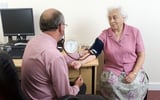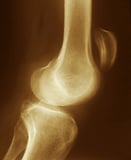How Do You Know Fracture V Lingament Tear
Sprains of the external (medial and lateral collateral) or internal (anterior and posterior cruciate) ligaments or injuries of the menisci may issue from knee trauma. Symptoms include hurting, joint effusion, instability (with severe sprains), and locking (with some meniscal injuries). Diagnosis is past physical exam and sometimes MRI. Treatment is Price (protection, rest, ice, compression, summit) and, for astringent injuries, casting or surgical repair.
Many structures that help stabilize the knee are located mainly outside the articulation; they include muscles (eg, quadriceps, hamstrings), their insertions (eg, pes anserinus), and extracapsular ligaments. The lateral collateral ligament is extracapsular; the medial (tibial) collateral ligament has a superficial extracapsular portion and a deep portion that is office of the joint capsule.
Ligaments of the knee
The most ordinarily injured knee structures are the
-
Medial collateral ligament
-
Inductive cruciate ligament
The mechanism of injury predicts the type of injury:
-
Inward (valgus) strength: Usually, the medial collateral ligament, followed by the inductive cruciate ligament, and so the medial meniscus (this machinery is the most common and is unremarkably accompanied by some external rotation and flexion, every bit when being tackled in football)
-
Outward (varus) strength: Often, the lateral collateral ligament, anterior cruciate ligament, or both (this mechanism is the 2d most common)
-
Anterior or posterior forces and hyperextension: Typically, the cruciate ligaments
-
Weight begetting and rotation at the time of injury: Unremarkably, menisci
Symptoms and Signs of Knee Sprains and Meniscal Injuries
Swelling and muscle spasm progress over the first few hours. With 2nd-degree sprains, pain is typically moderate or severe. With 3rd-degree sprains, pain may be mild, and surprisingly, some patients can walk unaided.
Some patients hear or feel a pop when the injury occurs. This finding suggests an anterior cruciate ligament tear but is not a reliable indicator.
Location of the tenderness and pain depends on the injury:
-
Sprained medial or lateral ligaments: Tenderness over the damaged ligament
-
Medial meniscal injuries: Tenderness in the joint plane (articulation line tenderness) medially
-
Lateral meniscal injuries: Tenderness in the articulation plane laterally
-
Medial and lateral meniscal injuries: Pain made worse by extreme flexion or extension and restricted passive knee movement (locking)
Injuries of any of the knee ligaments or menisci cause a visible and palpable joint effusion.
The ballottement (patellar tap) test can be used to check for joint effusion. It is best done when the patient lies supine. The examiner uses i hand to firmly slide downwards the quadriceps muscles toward the articulatio genus and stops several centimeters in a higher place the knee joint. With the other hand, the examiner taps on the patella. If the patella bounces (ballottes), the patella is floating in fluid, indicating a pregnant knee articulation effusion.
-
Clinical evaluation
-
X-rays to exclude fractures
-
Sometimes MRI
Diagnosis of knee sprains and meniscal injuries is primarily clinical. Stress testing is usually delayed considering the pain is then slap-up initially.
A spontaneously reduced genu dislocation Articulatio genus (Tibiofemoral) Dislocations Knee joint dislocations are commonly accompanied by arterial or nerve injuries. Knee dislocations threaten limb viability. These dislocations may spontaneously reduce before medical evaluation. Diagnosis... read more should be suspected in patients with a big hemarthrosis, gross instability, or both; detailed vascular evaluation, including ankle-brachial alphabetize (ABI) Ankle-brachial index (ABI) Consummate test of all systems is essential to detect peripheral and systemic effects of cardiac disorders and evidence of noncardiac disorders that might affect the heart. Examination... read more  , and CT angiography should exist washed immediately considering popliteal avenue injury is possible. Side by side, the knee is fully examined. Agile genu extension is assessed in all patients with knee pain and effusion to check for disruption of the genu extensor mechanism Knee Extensor Mechanism Injuries Genu extensor machinery injuries can involve the quadriceps tendon, patellar tendon, patella, or tibial tubercle. Surgical repair is usually required. (See also Overview of Sprains and Other... read more
, and CT angiography should exist washed immediately considering popliteal avenue injury is possible. Side by side, the knee is fully examined. Agile genu extension is assessed in all patients with knee pain and effusion to check for disruption of the genu extensor mechanism Knee Extensor Mechanism Injuries Genu extensor machinery injuries can involve the quadriceps tendon, patellar tendon, patella, or tibial tubercle. Surgical repair is usually required. (See also Overview of Sprains and Other... read more  (eg, tears of the quadriceps or patellar tendon, fracture of the patella or tibial tubercle).
(eg, tears of the quadriceps or patellar tendon, fracture of the patella or tibial tubercle).
Bedside stress testing is washed to check for specific injuries, although almost of these tests are not highly authentic or reliable. For bedside stress testing, practitioners movement the joint in a direction in which the ligament being tested commonly prevents excessive articulation movement.
For the Apley test, the patient is prone, and the examiner stabilizes the patient's thigh. The examiner flexes the patient's knee 90° and rotates the lower leg while pressing the lower leg downward toward the knee (pinch), and then rotates the lower leg while pulling it away from the genu (distraction). Pain during compression and rotation suggests a meniscal injury; pain during lark and rotation suggests a ligamentous or joint sheathing injury.
For evaluation of the medial and lateral collateral ligaments, the patient is supine, with the knee flexed most 20° and the hamstring muscles relaxed. The examiner puts ane manus over the side of the knee opposite the ligament being tested. With the other hand, the examiner cups the heel and pulls the lower leg outward to test the medial collateral ligament or in to examination the lateral collateral ligament. Moderate instability after acute injury suggests that a meniscus or cruciate ligament is torn every bit well as the collateral ligament.
Not every patient requires x-rays. Notwithstanding, anteroposterior, lateral, and oblique x-rays are often taken to exclude fractures. The Ottawa human knee rules are used to limit x-rays to patients more likely to have a fracture that requires specific treatments. X-rays should exist taken but if ane of the following is present:
-
Historic period > 55
-
Isolated tenderness of the patella (with no other bone tenderness of the articulatio genus)
-
Tenderness of fibular head
-
Inability to flex the knee 90°
-
Inability to carry weight both immediately and in the emergency department for 4 steps (with or without limping)
MRI is ordinarily not needed at the initial evaluation. A reasonable arroyo is to do MRI if symptoms do not resolve after a few weeks of conservative management. Notwithstanding, MRI is oftentimes done when severe injury or meaning intra-articular injury is suspected or cannot exist otherwise excluded.
Other tests may exist done to check for related injuries:
-
Arteriography or CT angiography to check for suspected arterial injuries
-
Electromyography and/or nerve conduction studies, which are rarely done immediately but more than typically done when nerve symptoms persist weeks to months later on the injury
-
ane. Rayan F, Bhonsle Southward, Shukla DD: Clinical, MRI, and arthroscopic correlation in meniscal and anterior cruciate ligament injuries. Int Orthop 2009 33 (one):129–132, 2009. doi: 10.1007/s00264-008-0520-four
-
ii. Benjaminse A, Gokeler A, van der Schans CP: Clinical diagnosis of an anterior cruciate ligament rupture: A meta-analysis. J Orthop Sports Phys Ther 36 (5):267–288, 2006.
-
Mild sprains: Protection, residue, water ice, compression, and pinnacle (Toll) with early immobilization
-
Severe injuries: Splinting or a human knee immobilizer and referral to an orthopedic surgeon for surgical repair
Severe 2d-caste and most 3rd-caste sprains crave casting for ≥ six weeks.
Some tertiary-degree injuries of the medial collateral ligament and inductive cruciate ligament crave arthroscopic surgical repair. Patients with severe injuries are referred to an orthopedic surgeon for surgical repair.
Meniscal injuries vary widely in their characteristics and treatments. Large, circuitous, or vertical tears and injuries that result in persistent effusions or disabling symptoms are more than likely to require surgery. Patient preference can influence choice of handling.
Physical therapy may be helpful, depending on the patient and the type of injury.
-
Stress testing (usually washed days after the injury) is necessary for differentiation of partial from complete ligamentous tears and is more sensitive than MRI.
-
Consider injury to the anterior cruciate ligament and other intra-articular structures if patients accept an effusion later an injury.
-
Consider knee joint dislocation and popliteal artery injury if patients accept a big hemarthrosis, gross instability, or both.
-
If patients have knee pain and effusion, test active knee extension to check for disruption of the extensor mechanism (eg, tears of the quadriceps or patellar tendon, fracture of the patella or tibial tubercle).
-
Practice MRI if symptoms practice not resolve after a few weeks of conservative management or possibly when severe injury or significant intra-articular injury is suspected or cannot be otherwise excluded.
Source: https://www.merckmanuals.com/professional/injuries-poisoning/sprains-and-other-soft-tissue-injuries/knee-sprains-and-meniscal-injuries
0 Response to "How Do You Know Fracture V Lingament Tear"
Post a Comment